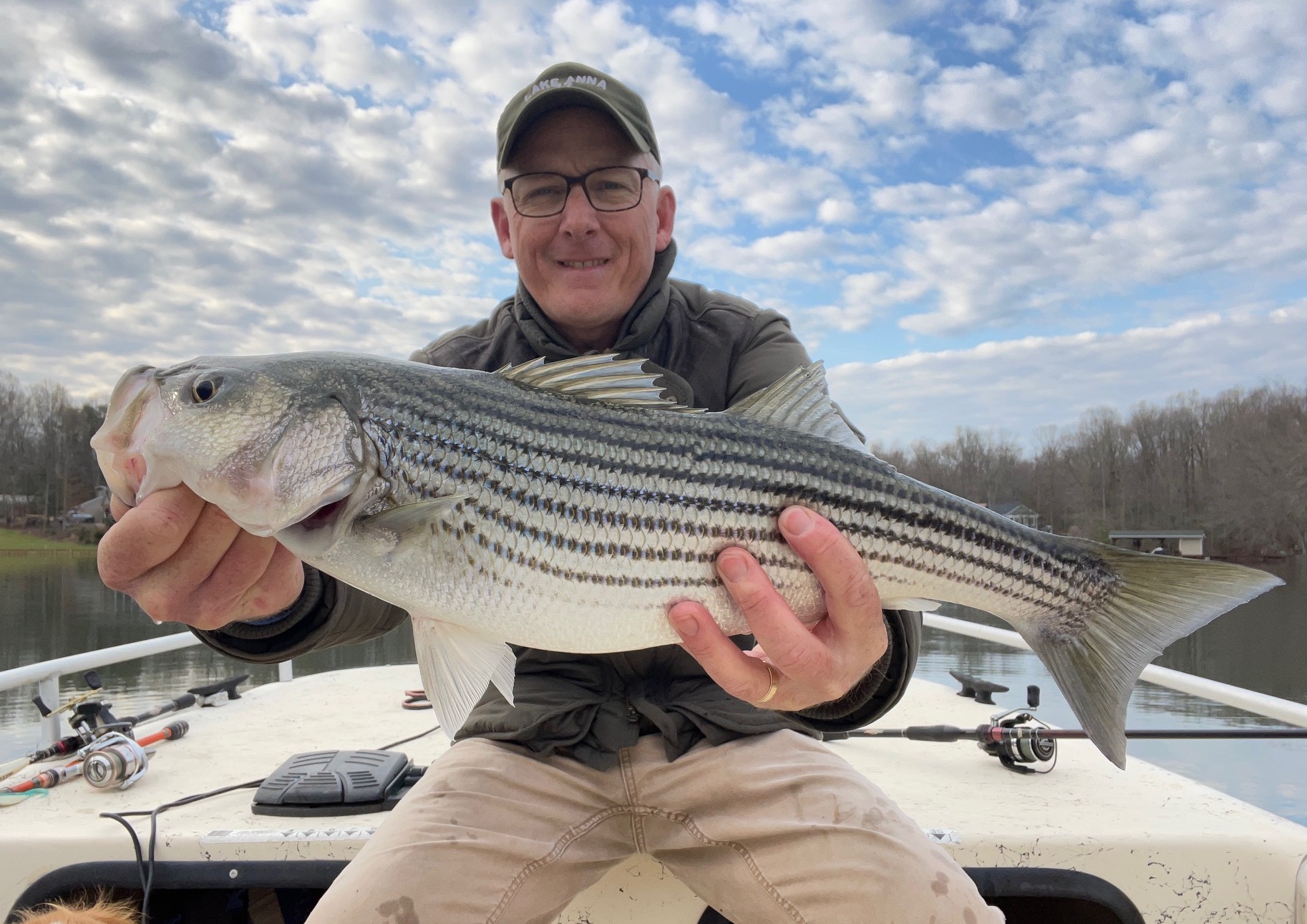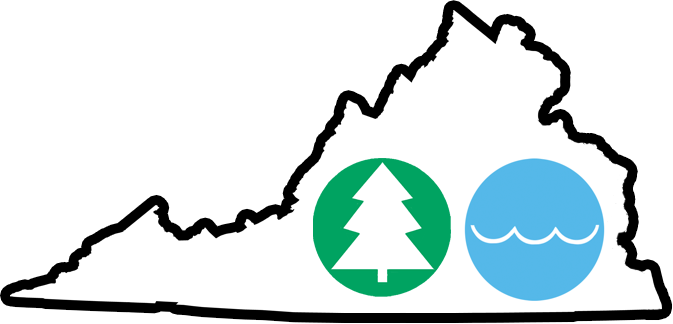Winter striper fishing can be as frustrating for novice anglers as well as veterans at times. Full stringers at the marina for some anglers and zero bites for others makes the ability to catch these landlocked rockfish appear almost mystical. I’ve done quite a bit of freshwater striper fishing and been with some of the region’s top guides, so I know that it’s not all hocus pocus.
I’m here to tell that if you are willing to do the work and understand striper behavior your social page can also be full of stringer shots.
Here’s some tips on how you, too, can catch winter stripers from the area lakes and reservoirs.
#1 Get Up Early
While you don’t always limit out by 8 am, getting up early must be part of a striper angler’s ritual. No matter if you are going to use bait or cast, you’ll want to be on the lake when it’s dark or just getting light. Baitfish collection is something you generally do before the sun rises as well.
Throughout most of the winter, the sun rises by 6:45-7:30 am. This gives you plenty of time to get up at 4:30 am (if you live near the lake you are fishing), hang your lantern on a bridge and hope it attracts herring or shad. A full tank of bait and its potential will make hearing the alarm worth it.
I’m serious. If you want to catch those bragging-sized limits, you need to get out of bed, make the effort to get bait and then be fishing as the sun rises and stick with it all day. If you are not a fan of using live bait, you will still want to get on the lake at dawn to see where baitfish are during calm conditions and possible even find feeding striper or other signs of activity like seagulls.
#2 Have The Right Equipment
Don’t make the effort to collect bait and put them in your livewell. They’ll all be dead within 10-20 minutes.
You must have a round baitwell. You must use granulated rock salt. You must use a bait treatment chemical. Foam Kill is another chemical most live bait anglers use.
John Worsky guides for me on Lake Anna and he uses a Creek Bank 30- and 50-gallon bait tank. He also has a custom-made 75-gallon Creek Bank tank for his house.
If your money’s stackin’ right, consider getting one of these insulated baitwells with a paddle agitator and filtration system. These tanks keep your water cooler longer and bait fresher.
Get the right rods, reels and line if you are going to fish with bait. Use 7’ medium action Ugly Stiks and an ABU Garcia C3 6500 or Okuma Coldwater reels. This is a universally accepted set-up and spooled with 12- pound Berkley Trilene XL will handle just about any striper in area lakes. Using a leader of 10-pound PLine fluorocarbon is sometimes advisable as well.
Circle hooks (#2) or Kahle hooks is the next matter to ponder. You just reel and pull gently with circle hooks. You have the satisfaction of a traditional hookset with the Kahle style.
How about depth finders? What kind is best? We’ll get to that in #5.
#3 Understand The Basic Rigs
You will need to know how to rig up and fish a free line, down line, shot line, free line on a side planer, cork line, umbrella rig, vertically jig a spoon, even a bottom line.
The first five rigs are used when fishing with live bait. Umbrella rigs are used when trolling. Vertical jigging can be excellent in the winter, too, for use under gulls or when the depth finder lights up. A bottom line is used when fishing cut bait.
You generally use live bait most effectively in the early and late winter when natural bait is plentiful and massed. Artificial lures start to produce better and better as the fish eat through and scatter the baitfish populations as winter progresses. Trolling can be good when the fish are suspended in the water column or roaming deep open water between feeding periods.
#4 Understand Striper Behavior
Stripers are land-locked rockfish, but they don’t act like their saltwater brethren. Lake stripers are finicky. They do not feed as often or as long as saltwater fish. There are no tides to spur the bite, only low light periods, water temperature, oxygen levels and baitfish concentrations. In fact, most lakes have vast areas very inviting to striper during the winter due to uniform oxygen levels and cool temperatures. It’s often more like hunting than fishing!
Once the water reaches 55 degrees the fish will move out of somewhat inconsistent behavior and fall haunts and begin to feed in shallower water. As the water cools further, the feeding activity will last longer and occur in even shallower water, often revealed by gulls and swirling fish and/or baitfish. If the water gets much below 40 degrees the action slows again to peak periods, especially early and late in the day and will occur in deeper water.
Striper tend to feed during periods of low light. This means early morning and right before dark. With the advent of live bait tactics that put shad, shiners and herring in the faces of otherwise non-aggressive fish 30-50’ deep you can often keep the good times coming during the day.
Take the time to understand striper behavior and movements. They do not stop swimming very often naturally. Combine this tendency with being chased by lure and bait-wielding anglers with clicking motors and depth finders and you get a fish that often stays deep and can move miles in minutes.
#5 Know How To Read Your Electronics
Perhaps the most important tool of the modern lake striper angler is a good depth finder. Choose one with high pixel count and screen resolution. Set these units up right and you can see fish below you at 35 mph. The new Humminbird, Garmin and Lowrance units offer users touch screens, side scanning, 3D imaging, real time sonar, mapping GPS integrated spot marking and track back.
Do you need all of this technology on your boat? Well, not if the birds are working right and the fish are in them, but wouldn’t you like to know what direction the school is moving before the other guys in the fleet? Forward facing and side scanning technology can help with that.
The former type of sonar is incredibly helpful when fishing for winter striper/wiper because you can see them harassing bait, chasing (or not) chasing your offerings and generally moving around. It’s fascinating to see just how fast they move!
To further understand what your depth finder is showing you, consider hiring a good fishing guide that can explain it to you. Also, try throwing a cast net when you see stuff you can’t place. To get really good with a depth finder it often takes years on your own, though.
#6 Have Striper Sense
It’s #6 for a reason because it’s like your sixth sense! Great striper anglers have a way of putting numbers 1-5 together to attain striper enlightenment. While it appears mystical, it really isn’t. Combine knowledge of seasonal patterns/behaviors, mix in a deep knowledge of the body of water, familiarity with many lures and techniques and use/mastering of technology, plus time on the water, friends and a little luck, and you have the recipe for a top striper angler.
Learn the ways of the striper Jedi and you’ll really look forward to this time of the year. Fail to heed this advice and you might be asking for fish at the end of the day!



